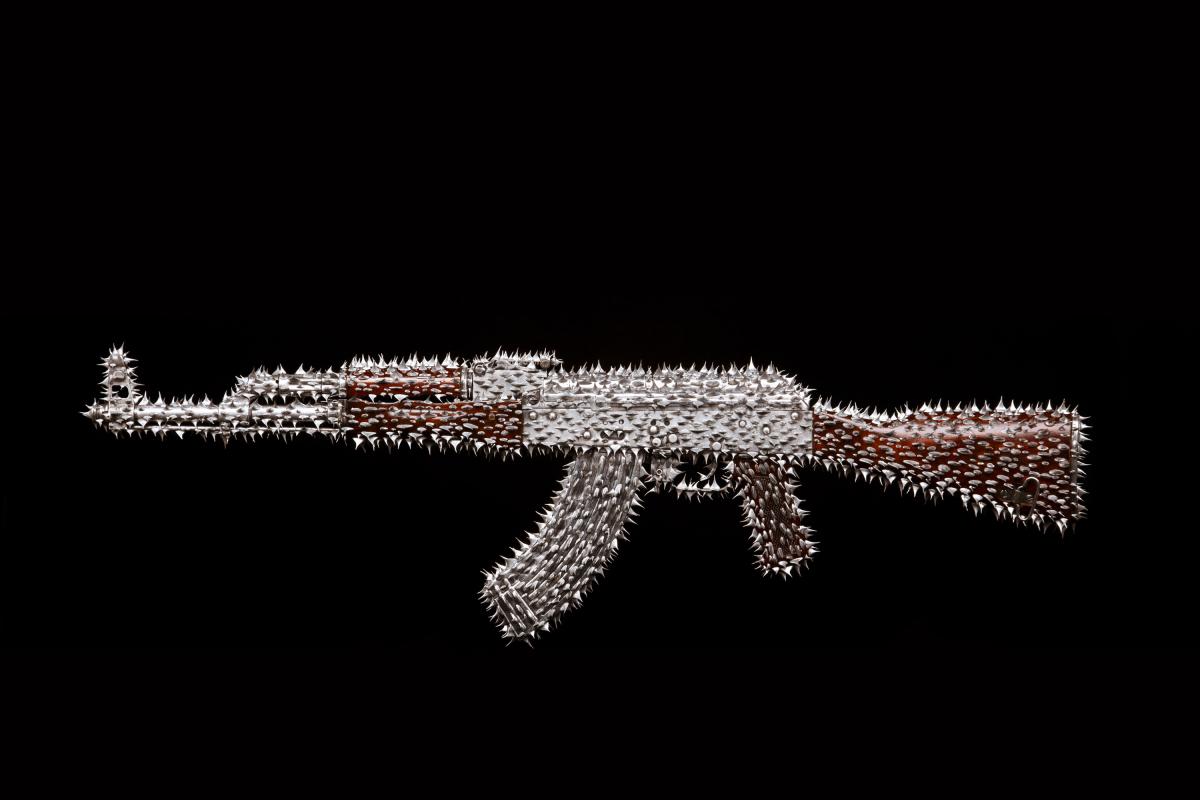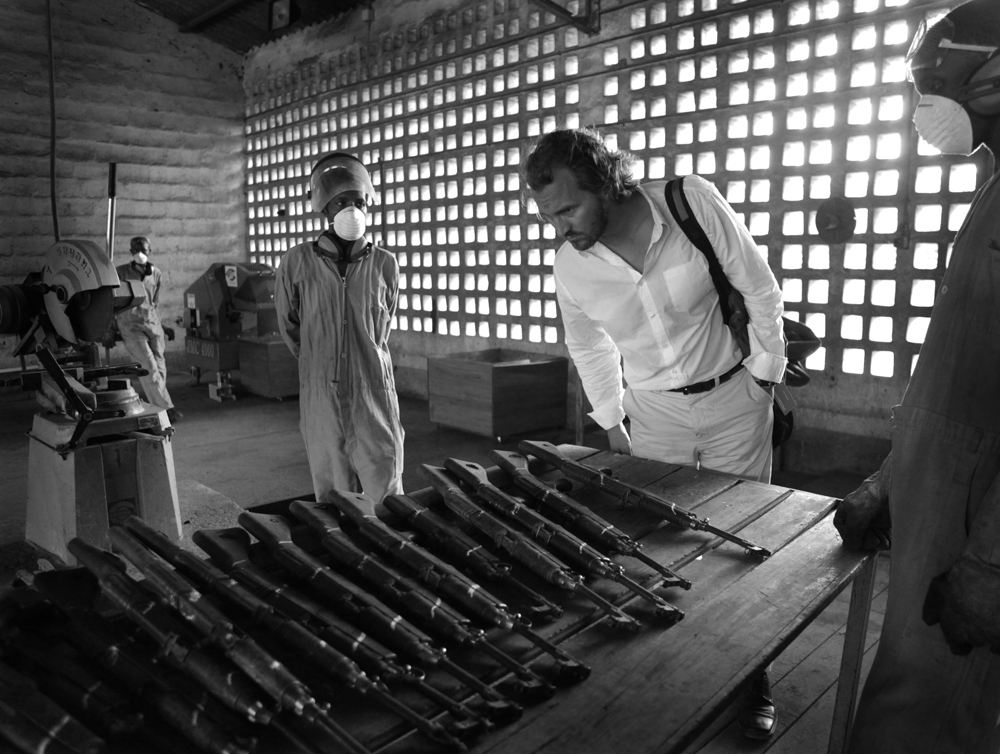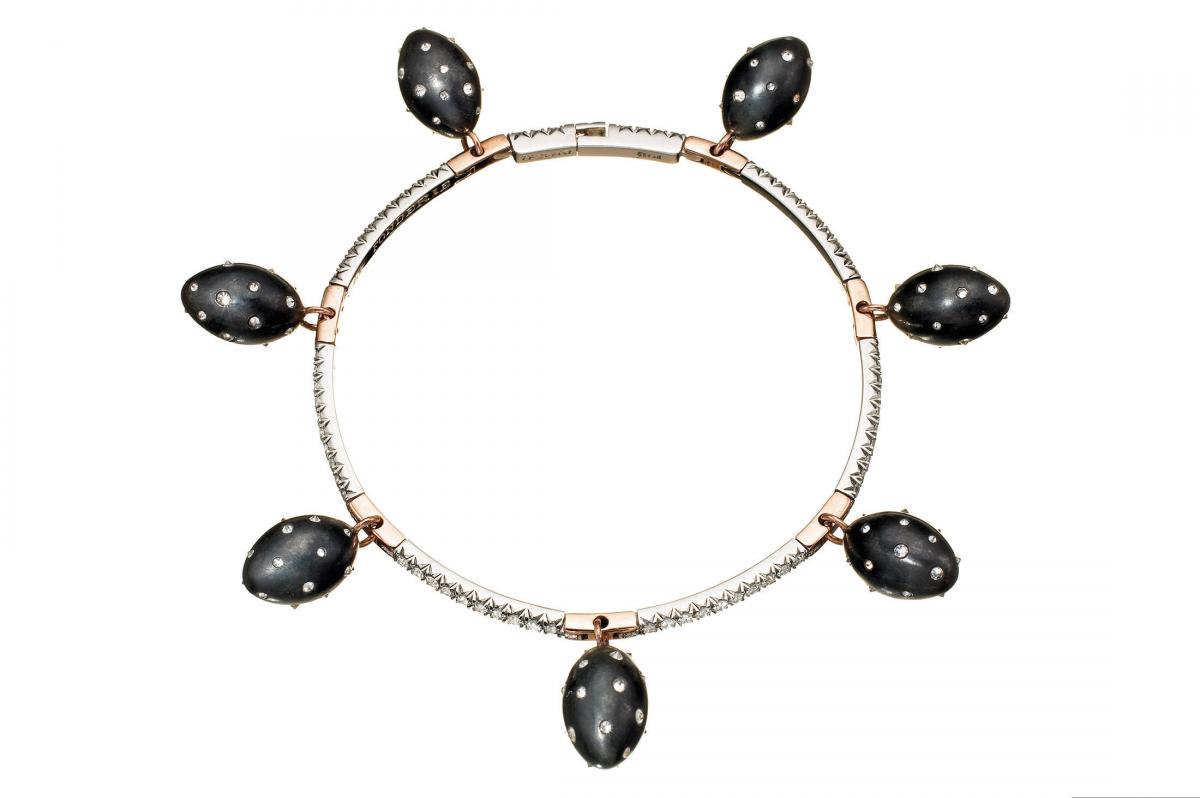The Art of Peace
Artists who transform weapons into opportunities to reflect on the violence in our world and even to take action against it.
Cover photo: The name AK-47 consists of the initials of the words Avtomat Kalashnikova (Russian for Kalashnikov Automatic Rifle), and the year when the prototypes were completed (1947). Required to be simple, reliable and lethal, it is an exceptionally well-designed weapon which can be disassembled and reassembled by an untrained person in less than 30 seconds. In the more than six decades since its creation, the Kalashnikov has become not only the most recognisable, but also the most abundant weapon ever created. It is manufactured in over 30 countries, and although nobody knows exactly how many there are, some estimates range as high as 100 million, or one for every 70 people in the world. Its numbers and its durability continue to pose a tremendous challenge all over the globe. (Photo: WTW)
‘And they shall beat their swords into ploughshares, and their spears into pruninghooks: nation shall not lift up sword against nation, neither shall they learn war any more.’
—Isaiah 2:4, King James Bible
In February of 2003, César López picked up his guitar and headed for a war zone. A car bomb had devastated a social club in his home town of Bogota, Colombia, killing 36 and wounding more than 200. Not knowing what else to do, a number of musicians brought their instruments to the site, playing music for the survivors and mourners who gathered there. López noticed that the soldiers responding to the incident held their rifles in the same way he held his guitar. Suddenly the idea struck him: he could turn a rifle into a guitar, transform an instrument of death into an instrument of music and a symbol of change.
López, working with Colombian luthier Alberto Paredes, covered the rifle barrel of an AK-47 with a smooth wooden guitar neck, running strings past the trigger to a bridge on the back of the receiver just above the pistol grip and placing the volume and tone knobs along the graceful curve of the rifle’s magazine. In López’s hands, the distinctive rat-tat-tat of fired rounds has been replaced by sounds of an altogether different sort.
There are estimated to be as many as 875 million firearms worldwide. They are sometimes likened to viruses, agents of a deadly plague of violence. But just as virologists create vaccines using weakened pathogens, a number of intrepid artists and designers are transforming decommissioned firearms into everything from guitars to sculpture to luxury jewellery. They take the potency of an instantly recognisable object and subvert it to powerful effect.
I was once shown a video of a weapons destruction task force uncovering a cache of rifles buried in a hillside in Mozambique. The guns had been hidden for nearly two decades and were coated in a thick layer of reddish-brown mud or rust. To prove a point, one of the men picked up a decrepit AK-47. He cleaned off a bit of the mud and poured oil from an equally rusty can into the gun’s receiver. Minutes later, the decades-old rifle still fired like a charm.
The Hope Throne is an unsettling, strangely ornate construction assembled from the detritus of war. Handguns, assault rifles, grenade launchers, shell casings and the curved magazine and stock of an AK-47, though transformed, are clearly distinguishable within its structure. Created in 2008, it is one of a series of thrones created by Mozambican artist Gonçalo Mabunda.
Even though the image of an AK-47 graces its flag, Mozambique is home to many artists who address the issue of violence by using reclaimed weapons in their work. In the wake of a civil war that ended in 1992, the Christian Council of Mozambique started Transforming Arms into Tools, an initiative encouraging citizens to exchange their firearms for items such as sewing machines, hoes, bicycles and construction materials. The more-than-600,000 firearms thus collected were then given to artists like Mabunda to symbolically manifest the transformation of violence into creation.
You seem to enjoy a good story
Sign up to our infrequent mailing to get more stories directly to your mailbox.‘The purpose of the project is to disarm the minds of people, and to disarm the hands of people,’ Bishop Dinis Sengulane, the organiser of Transforming Arms into Tools, told the BBC. ‘I felt I should be part of shaping that peace. And, of course, we find in the book of Micah, in the Bible, and in the book of Isaiah, in the Bible, where it says they will turn their swords into ploughshares, and people will sit under their own trees and nothing will frighten them.’

Familiar with the AK-47 from his service with the British Army in Afghanistan, photographer Bran Symondson conceived the exhibition AKA Peace, asking leading artists to turn decommissioned AK-47s from war-torn regions into works of art. The pieces were then auctioned off to raise funds for Peace One Day’s Global Truce campaign. This customised AK-47 with silver-painted thorns is work of Nancy Fouts. (Photo: Bran Symondson)
On my first visit to the British Museum, I wandered into a gallery that featured two of the most famous works to come out of Transforming Arms into Tools: Throne of Weapons by artist Cristóvão Canhavato (who works under the name Kester) and Tree of Life, a collective work by Kester, Hilario Nhatugueja, Fiel dos Santos and Adelino Serafim Maté. Like Mabunda, Kester works with the throne, a favourite subject of Mozambican artists, as a symbol of authority. The Tree of Life extends nearly 3.5m (12ft) tall, its rust-coloured trunk, branches and leaves made of the geometric forms of gun handles and ammunition magazines. The tree dominates its gallery, its power overwhelming the other items on exhibit.
To American artist Lin Evola, the guns she melts down to use in her sculptures aren’t active agents in violence but pure symbols of it. Her art is not about getting guns off the streets, per se. ‘If I could use ill will instead of weapons, I would,’ she told me. However, it was clear from the inception of her Peace Angels Project that her material of choice would be firearms.
Evola conceived of the Peace Angels in the autumn of 1992 when her son was eight years old and she was overcome with emotion from the thousands of gun-related deaths each year near her home in Los Angeles County. She felt paralysed. ‘I just couldn’t move,’ she said of the time. ‘I knew I had to do something as an artist, and it had to be with real weapons from real people.’ It took her two years to write the manifesto that became the Peace Angels Project.
AK-47s are the most widely used assault weapons in the world. What can a mere artist do to reduce their numbers?

Peter Thum, founder of luxury brand Fonderie47, inspects confiscated AK-47s. There are an estimated 20 million assault weapons in Africa, most of them AK-47 variants. The AK-47 costs 70% less in Africa than elsewhere in the world because of its abundance. Fonderie47 is a hybrid business model consisting of a for-profit corporation and a non-profit social venture that removes AK-47s from war zones and transforms them into upscale jewellery and accessories. To date Fonderie47 has funded the destruction of over 30,000 assault rifles in war zones in Africa. (Photo courtesy of Fonderie47.)
‘What I’m doing is taking something ugly and destructive, something we invented to kill each other, and transforming it to lift people up and show them our greatness and our potential to overcome that which destroys us.’
She combines metal from reclaimed guns, nuclear shell casings and land mines to cast metal sculptures of winged figures called Peace Angels. Her most famous sculpture, the Renaissance Peace Angel, was placed near the site of the attack on the World Trade Center, outside a canteen used by recovery workers. Over the many days and nights that it looked down on the restaurant, hundreds of people inscribed their names and messages of thanks on its base. The sculpture is now in the collection of the National September 11 Memorial & Museum in New York. Evola is currently working with the sheriff of Los Angeles to transform more than 100,000 weapons into a 9.8m (32ft) Peace Angel. Using metal from shell casings ensures that the work will not rust and degrade, something Evola believes would undermine the significance of the sculptures. ‘What I want is to create art that makes a difference to humanity and lives on past me, past all of us.’
In 2012, a group of 23 artists including Damien Hirst, Sam Taylor-Wood, Sarah Temple and Antony Gormley were each given an AK-47 to use in sculptures commissioned by the Peace One Day initiative, a non-profit organisation that promotes a global day of non-violence each September. The works created by these artists ranged from a rifle coated in a burst of bright paints (Hirst) to a rifle ground into dust (Gavin Turk). There was the bedazzled and butterfly-covered gun of Laila Shawa, and Bran Symondson’s politically motivated rifle découpaged with US dollar bills.
Whenever humanity feels sufficiently powerless, it resorts to the use of symbols: the voodoo doll with a human lock of hair, animal sacrifices to appease life-controlling gods, wedding rings to dictate who is loved and how. It is no wonder, then, that the desire to end violence should be enacted through manipulation of the objects that we use to kill, control and defend.
While most of the artists used the gun’s instantly recognisable shape to comment on society or create unexpected juxtapositions, artist Nancy Fouts took her piece in another direction. Covering the AK-47 in short, sharp spines, Fouts compellingly subverts the gun’s otherwise inviting physicality. Titled Don’t Touch, the work warns that in this case it is the wielder of the weapon who will suffer, not the wielder’s intended target, thus not only discouraging use of the gun, but also creating the potential for empathy.
Peter Thum’s signet ring, by contrast, builds on existing empathy that has already manifested itself in activism. It bears no design engraved on its surface. Rather, the material itself is a kind of seal, binding its wearer to the assault rifle from which it was made. Thum is the co-founder and CEO of Fonderie47, a company he formed in 2009 that creates luxury jewellery using metal from decommissioned AK-47s destroyed in Africa.
As we sipped coffee in a café near his office, Thum explained that the idea came to him when he was working in Africa for his previous venture, Ethos Water, a socially spirited company that funds the digging of wells in Africa through the sale of bottled water in the US. He travelled through Kenya and was struck by the number of firearms carried by the men and boys he met along the way. After selling his company in 2005, Thum decided that ‘the unique thing I can do is create an ecosystem of interaction between a problem and a group of people who, if they take ownership or partial ownership of a problem, can do something serious about it.’
He decided to apply Ethos’ social-business model to funding the destruction of guns. There are an estimated 40 million guns on the continent of Africa, perhaps half of which are assault rifles. Thum decided to focus on removing AK-47s because, he said, they are ‘the QWERTY keyboard of firearms. It’s one of the most recognisable “brands” on the planet. Even if someone doesn’t know the name AK-47, show them a picture, and odds are they’ll know that gun.’

This limited-edition bracelet made of sustainably sourced 18-karat gold and platinum, conflict-free diamonds and AK-47 steel costs US$70,000 (€51,600). Its purchase provides funds for the destruction of 300 assault rifles in Africa. Other pieces by Fonderie47 can finance the destruction of up to 800 weapons. Fonderie47 provides grants to UK-based NGO Mines Advisory, which carries out the physical destruction of the weapons in the Democratic Republic of Congo and in Burundi, in conjunction with staff of the local governments. (Image courtesy of Fonderie47.)
The metaphor of encouraging Americans to ‘take ownership of the problem’ is made literal through the purchase of Fonderie47 jewellery. The US$16,000 signet ring or US$50,000 pair of earrings you purchase is stamped with the serial number of the rifle incorporated into the piece. By buying the jewellery, you buy a connection to a specific gun, a connection to the problem. And that connection is more personal because of the nature of jewellery and the economic connections that Thum’s company builds.
‘Jewellery is something that you have to make a choice to wear on your body,’ he explained. The pieces, designed by craftsmen such as Philip Crangi and James de Givenchy, provide a way of effecting the symbolic and physical transformation of an object of violence into an object of beauty. ‘Then, in the retelling of that story to other people, that person becomes an evangelist for that idea. So if they’re particularly affected then ten of their friends want one of these things.’ Rather than simply display the objects in a public space or in a gallery, the owners of Fonderie47 jewellery wear them on their bodies, walking around with an advertisement for the cause. Every time someone compliments them on their jewellery, they can tell the story of its origin, talk about how many firearms were destroyed because of their purchase.
‘I think that there are millions of people who would like to see gun violence reduced in places around the world,’ Thum continued, ‘and they just need a way of expressing, embodying, and taking action around that.’
As diverse as these artists are, a common thread unites them: in spite of being overwhelmed by the problem of violence, not quite knowing how to address it as an individual, they feel an urgent need to take action against its tools and symbols. Though they do this by reshaping physical objects, their primary goal is to reshape thoughts and world views. The transformation of these weapons is no mere decoration. It is a means to help us think about why there is violence in the world and why we can’t seem to control it. As César López asks, ‘If the weapon, which was designed to kill, if its use can be changed, then why can’t humans change too?’

